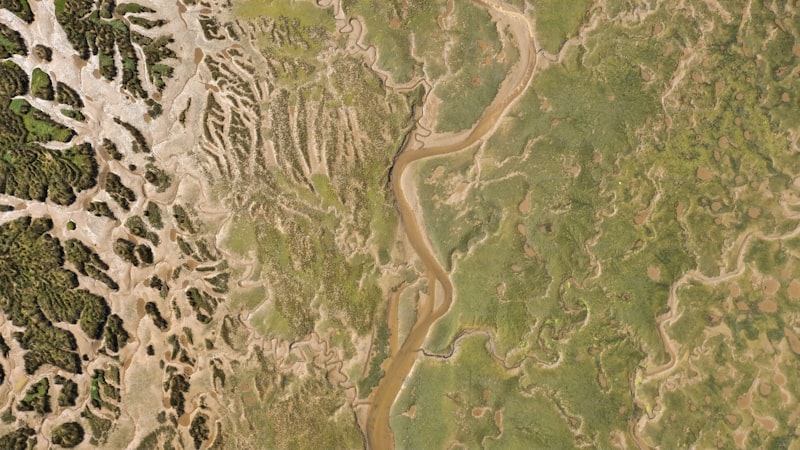Imagine a river as a giant chisel, steadily carving through rock and soil, creating valleys and canyons that stretch for miles. This relentless process of erosion is one of the primary ways rivers shape landscapes. As water flows downstream, it carries sediment and debris, gradually wearing away at the land. Over time, this can form deep gorges or wide floodplains, depending on the terrain and the river’s characteristics.
But rivers don’t just erode; they also deposit. When a river slows down, perhaps as it reaches a wider plain or enters a lake or sea, it loses the energy needed to carry sediment. This sediment settles out, layer by layer, building up deltas and alluvial plains. These fertile landscapes are often highly productive for agriculture, thanks to the nutrients brought by the river and the flat terrain created by its deposits.
Beyond erosion and deposition, rivers play a crucial role in shaping ecosystems. The availability of water allows diverse flora and fauna to thrive along their banks. Riverbanks provide habitats for a variety of species, from fish and amphibians to birds and mammals. The unique conditions created by rivers can also lead to the formation of wetlands and marshes, which support their own specialized communities of plants and animals.
In addition to their environmental impact, rivers have profoundly influenced human history and culture. Ancient civilizations like the Egyptians, Mesopotamians, and Chinese developed along major rivers like the Nile, Tigris and Euphrates, and Yangtze respectively. These rivers provided not only water for drinking and irrigation but also fertile soil for agriculture and transportation routes for trade and communication.
Nature’s Sculptors: How Rivers Carve Majestic Landscapes Over Millennia
Rivers are the silent architects of our planet’s most breathtaking landscapes, tirelessly shaping the Earth over millions of years. Imagine a mighty river, like the Amazon or the Nile, flowing relentlessly through rugged terrain, etching its path into the very fabric of the land. This process, known as fluvial erosion, is Nature’s own sculptor at work.
Picture this: as a river flows downhill, it carries with it sediment and debris. Over time, the constant movement of water against rock wears it down, slowly carving out valleys and canyons. The Grand Canyon in Arizona stands as a testament to the immense power of river erosion, its sheer cliffs revealing millions of years of geological history.
But it’s not just about wearing down rock. Rivers also deposit sediment along their banks and deltas, creating fertile plains and vibrant ecosystems. The Nile Delta, often referred to as the “Gift of the Nile,” owes its fertility to millennia of sediment deposition, sustaining ancient civilizations and modern agriculture alike.

Have you ever wondered how meandering rivers form those graceful curves? It’s a dance between water and land: as a river flows, it naturally seeks the path of least resistance. This leads to bends and curves that change over time, creating oxbow lakes and stunning meanders that enrich the landscape.
Consider the Colorado River, which carved out the majestic landscapes of the American Southwest. From the towering cliffs of Zion National Park to the iconic Horseshoe Bend, each formation tells a story of patience and persistence, where water transforms rock into natural wonders.
From Rapids to Valleys: Exploring Rivers’ Transformational Power on Earth
Imagine standing by a mountain stream, where water cascades down with unstoppable force, carving through rock and soil. These rapids symbolize the raw, untamed energy of rivers. They embody nature’s force, sculpting landscapes over millennia, and painting a picture of resilience and persistence.
As water descends from the heights, it begins a transformative journey. Rapids give way to calmer currents as rivers meander through valleys. Here, the river adopts a more tranquil demeanor, yet its power remains undiminished. Valleys witness the river’s ability to nurture life, supporting lush ecosystems and providing sustenance to countless species.

But a river’s impact extends beyond mere aesthetics. It serves as a lifeline for communities, offering resources for agriculture, transportation, and industry. The Nile, for instance, has sustained civilizations for millennia, shaping Egypt’s history and culture. Similarly, the Amazon, with its vast network of tributaries, sustains the richest biodiversity on Earth.

Moreover, rivers are conduits of culture and history. They have been highways for exploration and trade since ancient times. The Mississippi River in the United States, for example, played a pivotal role in the expansion of the country westward, facilitating commerce and settlement.
However, rivers are not immune to human influence. Pollution, damming, and climate change threaten their delicate balance. These challenges underscore the need for responsible stewardship of our waterways, ensuring that future generations can continue to benefit from their transformative power.
In essence, rivers are more than just water flowing downstream. They embody nature’s resilience, shaping landscapes, supporting life, and influencing human history. From rapids to valleys, rivers teach us about the transformative power of persistence and adaptation in the face of change.
The Erosion Engineers: Rivers’ Crucial Influence on Global Geography
Consider the Grand Canyon, a testament to the relentless power of the Colorado River. Over millions of years, this mighty river has patiently carved its way through layers of rock, exposing a breathtaking chasm that stretches for miles. It’s not just a sight to behold but a lesson in the sheer force of erosion.
But rivers aren’t just about grand canyons; they’re also about the intricate networks that lace our world. From the Amazon, pulsating through South America like a life-giving artery, to the Nile, nurturing civilizations in North Africa for millennia, rivers sustain ecosystems and human life alike.
Think about how rivers meander across plains, depositing rich sediment that fertilizes farmlands and sustains biodiversity. It’s a delicate balance of erosion and deposition, where rivers give as much as they take away.
And let’s not forget the cultural significance of rivers. They’ve been highways of exploration and trade for centuries, connecting people and cultures across continents. Just imagine the bustling ports along the Yangtze or the romantic charm of the Seine winding through Paris.
Today, our understanding of rivers goes beyond mere geography. It’s about conservation and sustainability. We’re learning to harness their power for renewable energy while protecting their delicate ecosystems. It’s a challenge that requires us to respect the natural forces that have shaped our world for eons.
In essence, rivers are more than just bodies of water; they are storytellers of our planet’s history, shaping our landscapes and our lives in ways both seen and unseen. Their influence is profound and everlasting, a reminder of nature’s power and our responsibility to preserve it.
Secrets of Sediment: Unraveling Rivers’ Impact on Land Formation
Imagine rivers as artists wielding brushes loaded with sediment instead of paint. As they meander through valleys and plains, rivers carry with them a diverse mixture of sand, silt, and clay. This sediment is no ordinary dirt; it’s a dynamic collection of mineral particles, organic matter, and even tiny bits of rock, all on a journey across the Earth’s surface.
But why does sediment matter so much? It’s because rivers are not just moving water; they are conveyor belts of geological change. When a river flows swiftly, it has the strength to transport larger particles like gravel and pebbles. As the current slows, finer particles like silt and clay settle out of the water, creating deposits called alluvium.
These deposits aren’t just random piles of mud; they are the building blocks of new landforms. Over time, layers of sediment can accumulate to form riverbanks, floodplains, and even entire deltas where rivers meet the sea. The Nile Delta, for example, is a testament to the power of sediment accumulation over millennia, creating fertile lands vital for agriculture and human settlement.
Rivers also have a knack for reshaping their paths over time, a process known as meandering. Picture a river snaking lazily through a floodplain, curving and looping back on itself. Each bend in the river alters the flow of water, causing sediment to be deposited on the inside of the curve and eroded from the outside. This continuous process not only changes the river’s course but also shapes the surrounding landscape.
Beyond Waterways: Rivers as Architects of Breathtaking Terrain
Consider the Grand Canyon, a colossal masterpiece etched by the Colorado River over millions of years. As the river meandered through layers of rock, it gradually exposed intricate patterns and vibrant colors, unveiling a geological tapestry that captivates millions of visitors annually. This iconic landmark stands as a testament to the transformative power of rivers, each twist and turn narrating a story written in stone.
But it’s not just about canyons. Rivers have shaped diverse landscapes around the globe, from the sinuous fjords of Norway, where glacial rivers have sliced deep into the coastlines, to the tranquil meanders of the Amazon, where the river’s gentle curves create fertile floodplains that nurture unparalleled biodiversity. Each ecosystem owes its unique character to the rivers that nurture and define it.
Moreover, rivers are not only sculptors but also connectors. They link ecosystems, cultures, and economies, serving as lifelines for countless communities worldwide. Consider the mighty Amazon River, not only a vital artery for South America’s biodiversity but also a crucial highway for trade and transportation. Its tributaries weave through dense rainforests, connecting remote villages with bustling cities, forging bonds that transcend geographic boundaries.
In essence, rivers are more than just bodies of water; they are the architects of our planet’s most awe-inspiring landscapes. Through their ceaseless flow, they shape mountains, carve valleys, and foster life in ways that continually astonish and inspire. As we marvel at their beauty and diversity, let us also remember their profound impact on the world we inhabit, a testament to the enduring power of nature’s design.
Frequently Asked Questions
Why are rivers important for biodiversity and ecosystem health?
Rivers are crucial for biodiversity and ecosystem health because they provide habitats for diverse species, support nutrient cycles, facilitate migration of aquatic organisms, and contribute to water purification processes.
What are the primary ways rivers shape landscapes?
Learn about the primary ways rivers shape landscapes, including erosion, transportation of sediment, and deposition. Discover how these processes create features like valleys, floodplains, and deltas.
How do rivers contribute to erosion and sediment deposition?
Learn how rivers shape landscapes through erosion, carrying sediment downstream and depositing it in new areas. Understand the processes of erosion and sediment deposition that rivers undergo, impacting landforms and ecosystems.
What role do rivers play in forming valleys and canyons?
Learn about the pivotal role rivers play in shaping valleys and canyons. Discover how the continuous flow of water erodes land over time, carving out deep channels and sculpting the landscape through natural geological processes.
How do rivers influence the formation of floodplains and deltas?
Rivers play a crucial role in shaping floodplains and deltas. Floodplains are formed when rivers overflow, depositing nutrient-rich sediment along their banks. Deltas form at river mouths, where sediment carried by rivers accumulates and shapes intricate networks of land and water. Both floodplains and deltas are dynamic ecosystems influenced by the continuous interaction between flowing water and sediment deposition.


